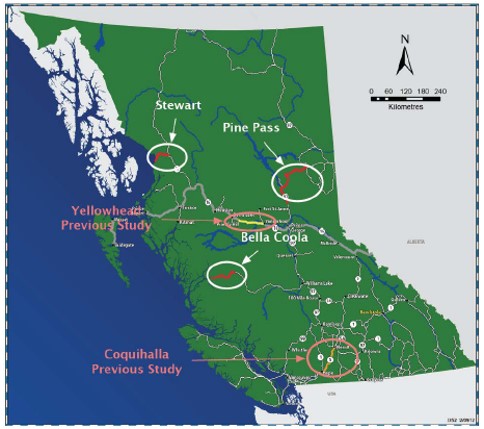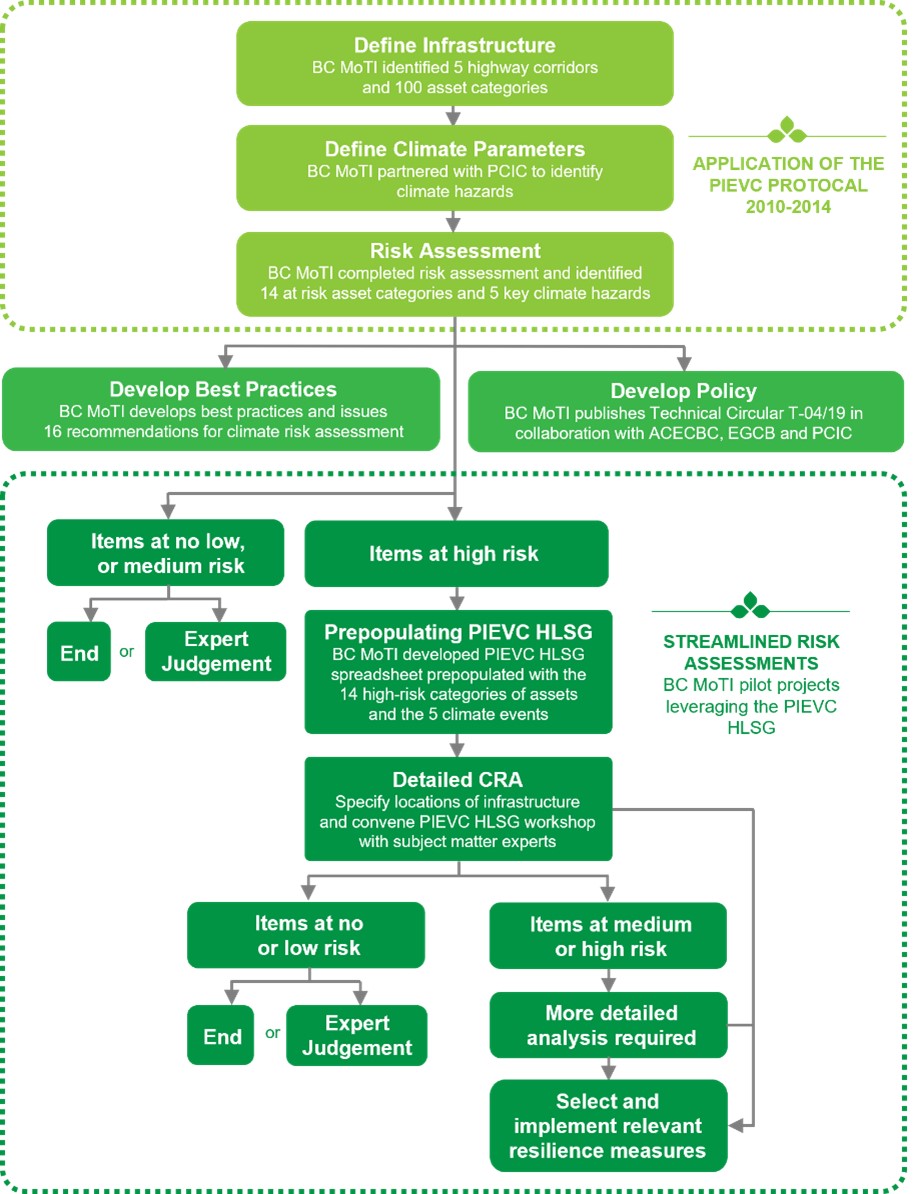TAC Sponsor Spotlight Article
Arcadis IBI Group has been collaborating with the BC Ministry of Transporation and Infrastructure (BC MoTI) and Infrastructure Canada (INFC) to develop guidance for achieving climate resilience. The journey that BC MoTI has taken can be an inspiration for other Canadian jurisdictions facing similar challenges.
The Need to Adapt
The pressures of climate change have been experienced in BC in the form of more frequent and severe weather extremes. The transportation infrastructure owned and maintained by BC MoTI is of critical importance. BC roads provide a lifeline to communities to receive goods and services needed for subsistence and have a direct influence on supply chains across Canada. As we learned from the November 2021 flood disaster in BC, losing this access can have disastrous consequences. Recognizing the challenge, BC MoTI developed a multi-disciplinary approach for achieving climate resilience. As of 2022, BC MoTI began exploring Systems Based Approaches as the next step in the journey toward climate resilience.

Pioneering a Multidisciplinary Approach
BC MoTI initiated a Multi-Disciplinary Approach to Resilient Infrastructure, circa 2006, undertaking the initiative to plan, design, and build infrastructure resilient to the increasing pressures of climate change. MoTI’s approach began in a collaborative effort as a member of the Public Infrastructure Engineering Vulnerability Committee (PIEVC), under the leadership of Engineers Canada. A fundamental tenet of PIEVC was that effective adaptation to climate change cannot be achieved without first understanding the risk to infrastructure. Thereafter, adaptation solutions to mitigate risk can be identified, prioritized, and implemented.
The work produced by PIEVC resulted in what is now known industry-wide as the PIEVC Protocol. The Protocol sets out a structured process that can be used in a consistent and replicable manner to assess climate risks to infrastructure.
Between 2010 and 2014, BC MoTI applied the PIEVC Protocol to five representative highway corridors in BC, ranging in length from 45 to 220 km. This application of the PIEVC Protocol involved a partnership with the Pacific Climate Impact Consortium (PCIC) to obtain and interpret climate projections. Workshops were then convened with multidisciplinary groups of Subject Matter Experts (SMEs) directly involved in the delivery of MoTI infrastructure, including SMEs for disciplines such as geotechnical, hydrotechnical and hydrological, electrical, environmental, operations, structural, and traffic. The PIEVC Protocol workshops provided a platform to systematically identify potential consequences and risks to road infrastructure based on climate hazard events described by climate scientists at PCIC. The PIEVC Protocol assessments yielded the following results:
- From an initial list of 100 asset categories (such as culverts, retaining walls, signage, bridges, asphalt, etc.) only 14 asset categories were determined to be at high risk to climate change.
- The primary threats to these 14 high-risk categories were all related to interactions with five precipitation-based climate events.
From the findings in the five PIEVC Protocol assessments, BC MoTI published a Best Practices document in 2014, which includes 16 recommendations for completing climate risk assessments.

Incorporating Climate Risk into Policy
In 2015, based on lessons learned from the PIEVC Protocols and the conclusions in the best practices document, BC MoTI provided new policy in the form of Technical Circular T-04/19 (updated in 2019). The policy was developed in collaboration with a multi-association committee co-chaired by Dirk Nyland, BC MoTI’s former Chief Engineer and Zane Sloan, Senior Climate Risk Specialist at Arcadis IBI, and involved the Association of Consulting Engineers of BC (ACECBC), Engineers and Geoscientists of BC (EGCB), and the Pacific Climate Impact Consortium (PCIC).
Technical Circular T-04/19 identifies the expectations for all BC MoTI engineering design assignments. The policy requires design Engineers of Record to complete and submit a Design Criteria Sheet for Climate Change Resilience. The Design Criteria Sheet documents climate change adjusted design criteria, how climate change is being accounted for in the design, and the associated costs for adaptations.
Detailed Climate Risk Assessments
In 2022, BC MoTI began the next level of climate risk assessments utilizing a new tool: the PIEVC High Level Screening Guide (PIEVC HLSG). Zane Sloan at Arcadis IBI introduced the PIEVC HLSG to the BC MoTI, and then helped to coordinate and facilitate the first application of a detailed climate risk assessment. The PIEVC HLSG applies the same processes as the PIEVC Protocol but leverages a purpose-build spreadsheet to simplify and streamline climate risk assessments. The PIEVC HLSG is being applied to complete detailed climate risk assessments on individual projects during engineering design. The 14 categories of high-risk elements and five precipitation-based climate events, identified in the previous PIEVC Protocols, are prepopulated in the spreadsheet. The 14 categories and five climate events are expanded to reflect the context of vulnerable infrastructure for each specific project. Thereafter, the prepopulated template is sent to the project design team to insert locations of each infrastructure element being designed under each category of high-risk infrastructure.
Online workshops served as the platform for a multi-disciplinary team of Subject Matter Experts to apply the PIEVC HLSG climate risk assessment process. After completing climate risk assessment workshops with the PIEVC HLSG spreadsheet, the design team considers the reported risks, observations, and potential consequences. Thereafter, the designers develop and report solutions to mitigate the risks. Implementation of solutions concludes with the design and construction of resilient infrastructure in compliance with the Ministry’s policy: Technical Circular T-04/19.
Evolving to a Systems Based Approach
The multidisciplinary approach using the PIEVC Protocol and PIEVC HLSG is effective at identifying how climate change directly impacts system-wide infrastructure elements. However, infrastructure assets in a system, such as BC MoTI’s highway system, do not exist in isolation: they serve, and are served, by other systems. Considering and managing the interdependencies between multiple systems can become critical in the context of resilience: as experienced in the BC November of 2021 flood disaster, the failure of one infrastructure asset can have cascading effects throughout multiple sectors of the economy.
To address this challenge, BC MoTI in partnership with INFC have retained Arcadis IBI to research and develop guidance on how to improve the existing approach to climate resilience using Systems Based Approaches. A Systems Based Approach looks beyond individual assets to consider interrelationships between elements including physical systems, such as upstream hydrology, and human systems. A Systems Based Approach frames adaptation solutions to account for interdependencies, interconnectivity, as well as cascading impacts. Applied to the context of BCMoTI, the road infrastructure is a system: a cluster of various structural and non-structural elements that are connected and organized to achieve mobility. This cluster is one among many other clusters that are interrelated within BC and Canada, such as emergency services, municipalities, third-party utilities, Indigenous communities, supply chains, the tourism industry, etc.
Best Practices Review
Arcadis IBI first researched and synthesized Best Practices of jurisdictions from around the planet, regarding Systems Based Approaches to Resilient Infrastructure (SBARi). The lessons learned from country-level to city-level jurisdictions such as France, New York, Netherlands, Singapore, Calgary, Australia, and others, was that methodologies for adaptation to climate change are best served if adaptation takes into account interdependencies between infrastructure systems. Thereafter, engage those interdependent agencies and communities to implement infrastructure adaptations to climate change. In other words, stop working in silos and collaborate with others. Otherwise, opportunities to achieve climate resilience might be lost.
From Theory to Practice
Arcadis IBI’s report highlighted the complexity and characteristics of SBARi approaches from around the world. Building on these lessons, Arcadis IBI is now producing a guidebook for BC MoTI and INFC. The Guidebook will serve to help infrastructure practitioners across Canada apply a Systems Based Approach to climate resilience. The guidebook will be generic and practical so it can be applied to any infrastructure type, not just transportation. Stay tuned for more on this!

